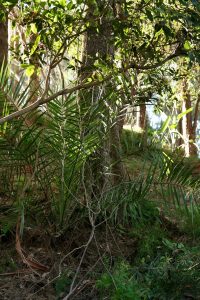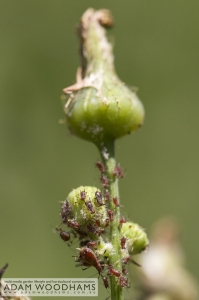Helping out during a working-bee at my little girls school I found myself on my hands-and-knees pulling weeds. Whilst in this rather awkward pose pondering the meaning of life I was blind-sided by a realisation, it rocketed in unseen, uninvited and was quite unexpected. As a gardener this realisation is one that leads me to a rather guilty admission – I’m in awe of weeds. No really, I am, and I think I’ve felt this way for some time. I’ve long had a degree of fascination and respect for them, they are just such worthy adversaries. Their tenacity, their survival ability, their modifications to resist destruction really are, dare I say it, admirable. Think about it. You pay a fortune for individual plants that you put in your garden and nurture. Like precocious children you give them everything they require and then some. And what do they do in return? They sulk and underperform never living up to their promise. Yet beside them, seemingly laughing at the under-performers, booming-and-blooming, will be a healthy crop of weeds resisting just about any attempt at removal, some even sneering back in the face of your muttered threats of launching chemical warfare, buying a goat or painted concrete slabs as a landscape option.
 Consider small-leaf or Chinese privet ( Ligustrum sinense ) with its ability to produce over 10,000 viable seeds a year from even just a small plant. Or onion weed (Nothoscordum gracile ) and its daughter bulbs that separate, sprouting independently, when the parent is pulled or poisoned or its seed heads that will continue to ripen even when stripped from the plant. Or dandelions (Taraxacum officinale ) that have evolved a weak-point so that when pulled they snap off at the crown leaving the tuberous taproot to re-sprout. Or agapanthus (Agapanthus praecox) that scatters masses of viable papery seeds to the four winds or can regenerate, cloning itself, from even just a small sliver of its tuber.
Consider small-leaf or Chinese privet ( Ligustrum sinense ) with its ability to produce over 10,000 viable seeds a year from even just a small plant. Or onion weed (Nothoscordum gracile ) and its daughter bulbs that separate, sprouting independently, when the parent is pulled or poisoned or its seed heads that will continue to ripen even when stripped from the plant. Or dandelions (Taraxacum officinale ) that have evolved a weak-point so that when pulled they snap off at the crown leaving the tuberous taproot to re-sprout. Or agapanthus (Agapanthus praecox) that scatters masses of viable papery seeds to the four winds or can regenerate, cloning itself, from even just a small sliver of its tuber.
Perhaps I should define ‘weed’ as this in itself is an interesting point.
The simplest definition is that a weed is any plant growing out of place. A more complex definition would be that a weed is any species that causes an ecological disturbance, environmental damage, displaces endemic species or disrupts economic crops through its introduction, growth and spread. The way a weed is defined can very much depend on who you talk with. I’ve heard hardcore purist bush regenerators describe a regionally endemic native species as a weed-invader when plants intended for planting in regeneration have been grown from seed that was not collected within the region they’ll be planted in.
Some native plants also quite naturally make great weeds. Sweet native daphne (Pittosporum undulatum) for example is known as an ‘adventitious coloniser’ as it has an amazing capacity to fill spaces in the bush very quickly after a tree falls or another opening in the canopy appears. So perhaps we’ll stay away from the specialist arguments, and just say a weed is anything you don’t want in your garden or lawn. And something that you may have noticed from the handful of plants I listed – a desirable ornamental plant in one area can be a serious environmental or nuisance weed in another.
 So why should you remove a weed? Well there are the obvious aesthetic reasons, as nothing looks worse than a bed smothered with a mish-mash of ferals. There are also very sensible reasons for keeping weeds down; weeds take water and nutrients that your desirable plants need, they can smother your plants or cut them off from sunlight. They can even serve as reservoirs for pests (as this shot of aphids on a sow-thistle shows) and diseases that can cause all manner of problems in your garden. Weeds may also jump the fence from your place into a neighbours yard or local bushland.
So why should you remove a weed? Well there are the obvious aesthetic reasons, as nothing looks worse than a bed smothered with a mish-mash of ferals. There are also very sensible reasons for keeping weeds down; weeds take water and nutrients that your desirable plants need, they can smother your plants or cut them off from sunlight. They can even serve as reservoirs for pests (as this shot of aphids on a sow-thistle shows) and diseases that can cause all manner of problems in your garden. Weeds may also jump the fence from your place into a neighbours yard or local bushland.
Dealing with weeds can be a conundrum in itself. I’m no weed professional but I’m a gardener so I’ll tell you how I handle these alien invaders.
Know your enemy. It pays to know what plant you’re dealing with as you’ll then have a better idea about any characteristics such as whether the plant can regenerate from parts left behind. There are many good online weed resources and your local Council is a good source of information. Many Councils in fact have a specialised weeds officer who may be able to help with difficult id’s.
And don’t forget you local garden centre – bag samples up and take them in to ask their horticulturist for help.Let them grow. Sounds counter intuitive, right? Slightly bigger weeds are easier to pull (generally) and you’re more likely to get the whole plant. Another advantage too is that you’ll know that what you’re removing is in fact a weed. Through letting things grow-on a little before acting I now have some lovely native plants in my garden, such as Australian bluebells, that I was only able to correctly identify when they were larger.Consider chickens. Chooks are great weed-eaters. They love little green plants but just be aware that can also include any seedlings you plant…Make it manual. Unless you are left absolutely without choice, avoid using herbicides and, if you must resort to using them, spot rather than blanket spray. Instead invest in some quality weeding tools such as a thin hand-trowel, a daisy-grubber and a small garden knife and remove by hand instead.Timing is everything. Always make sure that you get weeds before they set seed otherwise pulling them can spread the seed near and far in your garden. And wait until after rain (or irrigation) for a big weeding session. It’s much easier to pull weeds from moist soil.Mulch. Mulch is fantastic at suppressing weeds. Funny thing is though – it’s not uncommon to hear tales of people complaining of more weeds after mulching. Here’s what happens – weed seeds can lay dormant in the soil for years, decades even, just waiting for the right conditions. When you mulch you improve soil moisture and nutrient levels and Bingo! You can trigger those seeds. This is one of the reasons you may wish to consider putting a suitable permeable weedmat down before spreading your mulch. But don’t fret too much, you’ll find weeds are easier to pull from mulch than regular soil as the soil will be nice and moist underneath it. Any new weeds seeds that germinate in the mulch are a breeze to pull out.Take care when tossing. Weeds can be composted but only if your heap runs nice and hot otherwise seeds or other propagules may not be destroyed and can pop-up once the compost is used in your garden.
Really nasty weeds such as wandering jew or trad’ (Tradescantia albiflora) that can regrow from every single part are best neutralised using the power of the sun. Stick them into a black plastic garbage bag, tie it closed and leave it in full-sun to cook for a few days. You can also use you local Council greenwaste collection service if you have one.
So there you have it, a bit of gardener’s wisdom on an enemy that perhaps deserves a bit more respect, well, at least until you terminate them with maximum prejudice.
